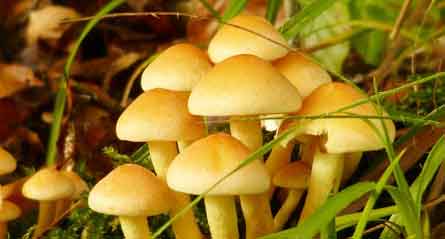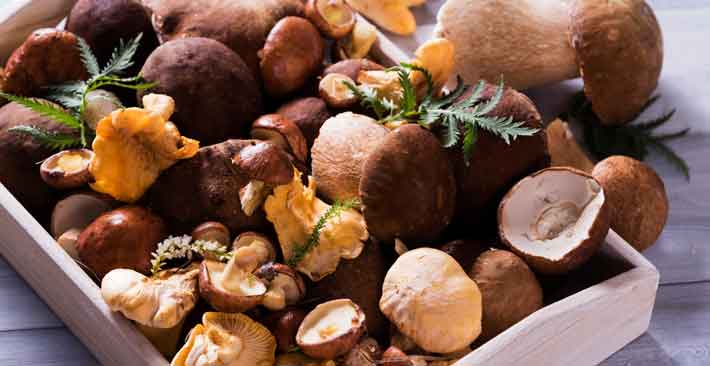Wood, paper, or cardboard items that are stored or left in moist, dark places such as basements, are sure to encourage and permit mold growth. Mold growth occurs and appears, sooner rather than later, in many moist places such as: refrigerators, old logs, fences and even on plastic surfaces. The odors of basements, fuzzy growths on fruits and vegetables, and dark brown to black spots on walls, wood, and exterior surfaces of buildings and walkways are sure signs that mold is alive, well and thriving. Molds are part of life’s fabric and ecosystems, and molds are good to know and understand.
Teaching About Molds and Fungus Growth

Here are the main definitions to use at the beginning of the mold experiments, and as a summary for study of molds.
- Mold. A member of the Fungus Kingdom (Mycota). Fungi usually produce hyphae and spores. Common examples, include Penicillium spp. and common mushrooms. See photos below.
- Mold Colony. A distinct, visible, growth of filamentous fungus (mold).
- Hyphae (hypha, sing.). Mold threads that enable the mold to extend and grow outward, upward and downward as the mold seeks out food.
- Mycelium is a mass of hyphae.
- Spores are usually thick-walled, reproductive structures produced by the molds. Spores resist drying. Spores permit the fungus to be carried by wind and water to new places where the fungus may find more food to start new mold colonies.
Molds Eat, Grow, Simply and Easily
Mold spores are small structures that are found in air, soil and water. Spores are resistant to drying and they can float in air and water. Spores germinate and begin to grow when there is sufficient moisture and suitable simple food such as cellulose or starch. Each mold spore produces a germ tube hypha, and then expands into many hyphae which resemble threads, or small root-like structures (see hyphae photo below). The mold usually produces exoenzymes that digest the surrounding cellulose or starch, and change these into digestible glucose, check more details here.
How to Grow, Cultivate and See Molds
To see molds this experiment requires the following materials:
- Disposable, clean, clear, glass jars with screw-on lids to seal the top of the jars. (Jars without lids may be covered with plastic wrap.) Baby food, jam or jelly, pickle or relish, tomato sauce or salsa jars are all suitable if washed thoroughly. Remove the label to promote clarity.
- Food or nutrients for the fungus include: strawberries, grapes, cardboard, tissue paper, napkins, melon skins, apples or cheese, or jello. Small pieces of each of the previous, about 1 to 2 inches (2.5 to 5 cm) in diameter, are of sufficient size.
Mold Growth Procedures, Methods and Observations
- Place or drop a few pieces of any of the above foods, about 1 to 2 inch (2.5 to 5 cm), into the bottom of each jar and close with a lid.
- Label the jar with the date and time of addition of the food.
- Make sure that cardboard, paper, or tissue is saturated with water (not floating in water, just moistened thoroughly).
- Check the jars each day. Mold should begin to appear by day 5-7, and distinct fuzzy growth of hyphae should appear.
- Note when the hyphae change color to black, gray, and/or powdery, indicating the formation of spores.
- The jars may be observed for up to one month.
What should one do with the jars when the experiments are finished and over?

- either toss the jars away without opening the lid or plastic covering (for most people this is preferable);
- or, carefully add undiluted,antiseptic mouthwash to each container, sufficient to cover and saturate all the mold and its hyphae and spores. After treatment with concentrated mouthwash for approximately 4 to 6 hours, or the next day, all the mold hyphae and spores should be dead (non-viable). The mouthwash and liquid may be drained into a sink with running hot water, and the residue of fungus food may be shaken or dropped into an intact, strong, disposable garbage bag and discarded; wash jars and lids thoroughly with liquid detergent, rinse and dry the lids and jars, and when all this is finished please remember to —
- wash hands thoroughly with soap and water, and dry them.
Molds are interesting to study, and important to understand. From Penicillium to giant mushrooms, these filamentous fungi are a reminder that the moldy world is here to stay.











 A Review of Gizmo5’s Voice Over IP Software
A Review of Gizmo5’s Voice Over IP Software